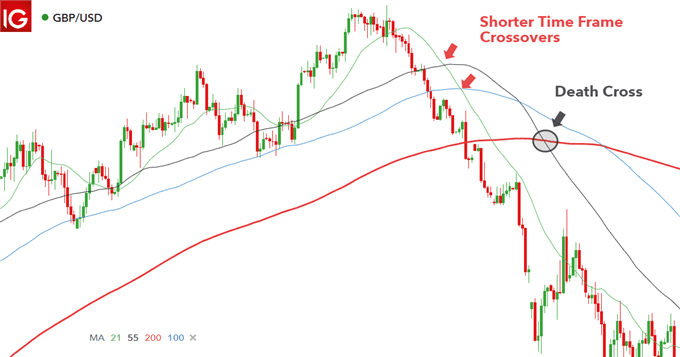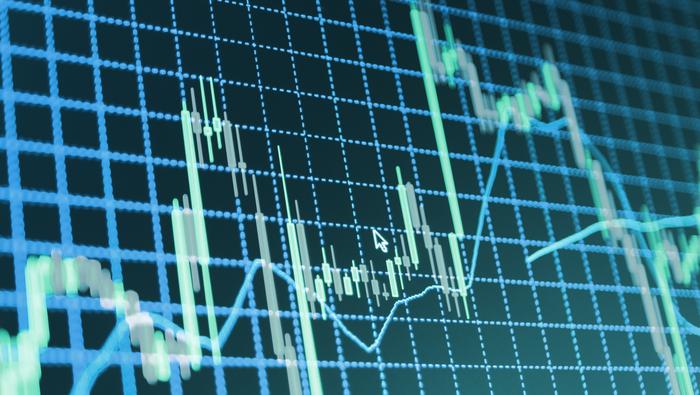Popular Simple Moving Averages
Moving averages are extremely popular due to their easy-to-use nature and multitude of uses when trading. There are a number of popular Simple Moving Averages (SMA), however, each will be determined by trading style and the desired time frame when trading. The most popular simple moving averages include the 10, 20, 50, 100, and 200.
Traders often use the smaller, faster-moving averages as entry triggers and the longer, slower-moving averages as clear trend filters.
Popular Exponential Moving Averages
While the most popular Exponential Moving averages (EMA) look very similar to the SMAs, the actual data points that make up the EMA will differ due to the way it is calculated. The EMA calculation attributes a higher weighting to recent price moves compared to the SMA, which takes a general average over the specified time period. The most popular simple moving averages include the 10, 20, 50, 100, and 200.
Traders interested in Fibonacci numbers prefer to replace the popular moving average numbers with Fibonacci numbers.
The standard moving average settings:

Fibonacci moving averages:

There are a number of moving averages each with different formulas. Over time, formulas have been altered in an attempt to better track price. Therefore, traders have a decent selection of moving averages to choose from, some of the most popular include:
- Hull Moving Average
- Weighted Moving Average
- Smoothed Moving Average
- Simple Moving Average
- Exponential Moving Average
Read our article on moving averages for detailed examples on how to calculate both the SMA and EMA.
Why moving averages are popular
Moving averages are simple to use and can be effective in recognizing trending, ranging, or corrective environments. Often traders will use more than one moving average because two moving averages can be used as a trend trigger. In other words, when the shorter moving average crosses above the longer, slower moving average, this can be viewed as a cue to enter long. The long trading bias remains until the moving averages reverse or the target is hit.



The EUR/USD chart below shows the 200-day moving average acting as support and a clear trend filter. Price approaches the 200-day MA before bouncing back up in the direction of the long-term trend.

Pro Tip: It is best to stick to a few specific moving averages. This will prevent traders from trying to find the “perfect moving average” and will help traders to stay focused on whether the trend is starting, accelerating, or slowing down.



Who uses moving averages
Moving Averages are most popular to new traders, for good reason. They help traders to define the trend and potential entries in the direction of the trend. However, moving averages are also utilized by fund managers and investment banks in their analysis to see if a market is nearing support or resistance or potentially reversing after a significant period.
The EUR/USD chart below depicts the slowing down of upward momentum in the long-term trend as the price drops and closes below the 200-day moving average. A close below the 200-day MA alerts traders to the possibility of a reversal in the long-term trend.

Moving averages can be a simple tool to define support and resistance in the forex market. When a market is in a strong trend, any bounce off a moving average presents an opportunity to join the trend until the price closes below the 200-SMA. However, if the price persistently moves above and below the moving average in a short period of time, this is likely to be a range, meaning those reversals are less significant from a trading point of view.
How to use the popular moving averages
There are many uses for the popular moving averages but a simple system is to look for a moving average crossover. The moving average crossover looks for the short or faster moving average to cross above an already rising longer or slow-moving average as a buy signal. When looking to sell a currency pair, traders can look for the short or faster moving average to cross below a falling slower moving average as a sell signal.
The most well-known moving average crossovers involve the 50 (51) and 200 moving averages.
| Name | Crossover | Resulting signal |
|---|---|---|
| Golden Cross | 50 crosses above the 200 | Bullish crossover |
| Death Cross | 50 crosses below the 200 | Bearish crossover |
The Death cross is presented in the GBP/USD chart below:

Frequently Asked Questions (FAQs)
What time frame must I use when trading with moving averages?
Moving averages can be used on any time frame. However, the time frame you decide to use will depend greatly on the type of trader you are. Traders with lots of time to spend in front of the charts may prefer ‘scalping’ and will, therefore, use hourly or 15-minute charts. On the other hand, traders short on time will tend to prefer longer time frames such as the 4-hour or daily charts.
Can moving averages also be used to exit trades?
Yes, moving averages are just as relevant about exiting trades as they are for entries. Bearish crossovers witnessed on existing long positions could be taken as a signal to exit the trade. Knowing how to exit trades is crucially important in trading. In fact, this was one of the major takeaways when we researched the traits of successful traders.



